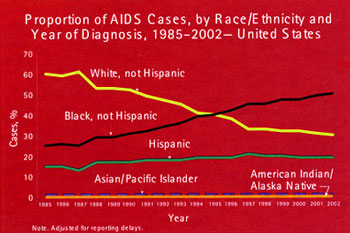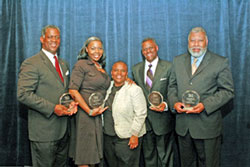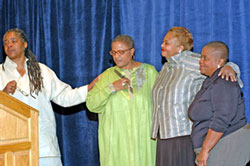There is indeed a Balm in Gilead

CHARLESTON, S.C. (FinalCall.com) – Twenty-five years fighting HIV and AIDS, and Black people are infected today at rates as high as when Whites were diagnosed in 1985. Twenty-five years fighting HIV and AIDS and Black teens are becoming infected. What is wrong with this picture? What can we do to reverse this startling trend of death treading its path through the Black community?
Since the first diagnosis of the disease on June 5, 1981 by Dr. Michael Gottlieb of five of his White gay patients at the University of California, Black people have increasingly been diagnosed with the disease. Nearly half of the more than one million Americans estimated to be living with HIV/AIDS are Black. Over 56 percent of the new cases among youth arise in the Black community. And Black women have become the face of HIV/AIDS, with nearly 70 percent of new cases among women.
“Is there no balm in Gilead; is there no physician there? Why then is not the health of the daughter of my people recovered?” (Jeremiah 8:22)
***

There is a Balm in Gilead–and it was founded by Pernessa Seele 17 years ago. Fueled with a fiery vigor, Ms. Seele has spearheaded several programs to bring the Black church into the vanguard position in the battle to stop the killing of Blacks from a multitude of 100 percent preventable diseases, particularly HIV/AIDS. One such program is the Black Church Institute on HIV/AIDS and Other Health Disparities.
This year, the conference was held in the deep southern city of Charleston Oct. 24-27 under the theme, “Building the Capacity of the Believer to Serve,” with focus points on healing, advocacy, education and service.
“Let’s have a new debate. Pastors need to have real honest dialogue in our communities because our people are dying,” stressed Ms. Seele during the opening awards reception, “and they only listen to the pastors; they don’t even listen to the doctors. We must learn how to bring healing into our churches because the church must light the way.”
The Institute is exclusively designed for leaders of Black churches who strive to increase their knowledge about HIV/AIDS and other diseases and strengthen their commitment to education and supporting those who suffer. The Balm in Gilead is a not-for-profit, non-governmental organization whose mission is to improve the health status of people of the African Diaspora by building the capacity of faith communities to address life-threatening diseases, especially HIV/AIDS. Endorsed by numerous national church denominations, caucuses, coalitions and mosques, it has developed educational and training programs to meet the specific needs of churches and mosques that strive to become centers for health education, compassion and care.
Moving beyond the all too familiar shock of the most recent statistics, resonating issues of the four-day conference was how to effectively establish an AIDS ministry within a church; how to broaden the reach of testing, education models and public policy; how to heal the divisions, stigma and hatred surrounding HIV/AIDS within congregations and communities; and how to positively deal with sexuality in faith communities. The Institute also expanded its scope to discuss cervical cancer, renal disease and the emerging crisis of the spread of Hepatitis C.
A highlight of the week’s sessions was the provocative performance of actress/singer Sheryl Lee Ralph, who presented an excerpt of her touring one-woman show, “Sometimes I Cry,” recounting in touching detail the stories of women living with HIV/AIDS. A frank family discussion was convened on the third day of the conference. Christopher Bates, director of the office of HIV/AIDS Policy in the Department of Health and Human Services, acknowledged the “deception in government” in sometimes not telling the whole truth of a crisis.

“We have to take responsibility for one another. So I implore you to move outside the church and into the street,” he said. “Church would be a very lonely place if all of its members are dead.”
He informed the session participants that nearly 300,000 American citizens do not know their HIV status, calling for a fundamental shift in HIV prevention.
“It’s no longer acceptable. There is a thing called stigma that still rides along the conversation on the road to HIV testing and it has served as a significant barrier,” he remarked. “We must shift to make mandatory testing in all clinical settings. Physicians are advised to include in standard diagnostic testing HIV testing.”
Debra Fraiser Howze has been instrumental in obtaining funding for organizations struggling to implement and maintain effective programs. As president and CEO of the National Black Leadership Commission on AIDS, she has used her astute skills in grant writing to bring needed assistance.
“I don’t believe that the Black church should be doing much without a dime. The Catholic Church doesn’t do anything without money. The Vatican is full of gold. They know money; they like money and respect money,” she observed. “There is nothing wrong with money; it is not evil if you use it for good.”
The conference was also marked by the historic unity of the three major Methodist denominations–the African Methodist Episcopal (AME), Christian Methodist Episcopal (CME) and African Methodist Episcopal Zion (AMEZ)–with the international presidents of the women’s missionary of these denominations standing together to issue a call to commitment at the conclusion of the conference. When this partnership was first announced two years ago, it was remarked by a senior bishop that the women have done what the Methodists have been trying to do for over 300 years–unite.
But Methodist Episcopalians were not the only tradition represented. Representatives from the Pentecostal Church, National Baptist Convention and other independent church ministries were present. Both laity and leaders convened with city, state and federal health officials for a power-packed daily schedule of plenary sessions and workshops.
Each day began with an early morning worship session followed by plenary sessions that were so filled with spontaneous praises of “Hallelujah” and “Amen” that the conference in its entirety could be classified as “church.” But that was indeed the purpose of the Balm in Gilead in the first place–to bring the Presence of God through those that claim to follow Him to bear on the fight against the scourge of HIV/AIDS.
“And as he entered into a certain village, there met him ten men that were lepers, which stood afar off: and they lifted up their voices and said, Jesus, Master, have mercy on us.” (Luke 17:12-13)












